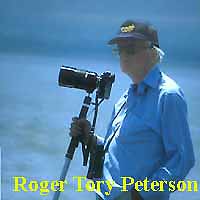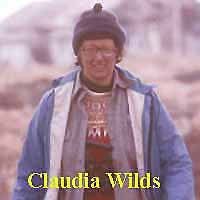 Roger
Tory Peterson was, in many ways, the father of modern birding. His
field guide series, starting with the Field Guide to Birds in 1934
(covering eastern North America), revolutionized the way people looked
at birds. As Kenn Kaufman explained in his Field Guide to Advanced Birding
(1990) 'Simplicity was the keynote of the Peterson System. No matter than
some female ducks, for example, were plain and brown; the beginner could
ignore them. . .The original Peterson guides bypassed the technical details
and made it possible for anyone to name most of the birds most
of the time. The very simplicity of this approach has undoubtedly been
a major factor in the tremendous growth of interest in birding." [emphasis
added] Roger
Tory Peterson was, in many ways, the father of modern birding. His
field guide series, starting with the Field Guide to Birds in 1934
(covering eastern North America), revolutionized the way people looked
at birds. As Kenn Kaufman explained in his Field Guide to Advanced Birding
(1990) 'Simplicity was the keynote of the Peterson System. No matter than
some female ducks, for example, were plain and brown; the beginner could
ignore them. . .The original Peterson guides bypassed the technical details
and made it possible for anyone to name most of the birds most
of the time. The very simplicity of this approach has undoubtedly been
a major factor in the tremendous growth of interest in birding." [emphasis
added]
Almost all California birders in the era under consideration here grew up on the Peterson field guides, learning patterns and field marks. Almost all of us owe him a great debt of gratitude. As the frontiers of field identification were pushed forward in the '70s and '80s, and hardcore California birders wanted to get closer to naming all of the birds all of the time, new guides and techniques were needed. We started placing birds to specific age groups, and studying greater coverts, certain rectrices, and tertials. Roger used to complain to me that this trend was like going backwards in time — back to the museum trays where the ornithologist looked at individual feathers. But nonetheless, Roger heartily supported projects like Kaufman's Advanced Guide, and published it within the Peterson Field Guide series. Roger continued as a sharp field birder in his later years. He was 75 years old when he joined California's record-tying Big Day team in 1983, and kept to the hot pace throughout the 24 hour event. Roger lived to age 87; he died in 1996. Photo of Roger Tory Peterson from the north end of the
Salton Sea, looking for the State's first Spotted Redshank, May 1983 ©
D. Roberson
|
||
 Claudia
Wilds was one of the most important birders in the eastern United States
during the 1970s and 1980s. Her birding beat was centered around Washington,
D.C., where she had ready access to the National Museum, and included Maryland,
Delaware, and New Jersey. With the growth of understanding of plumages
in our era, she became one of America's leading experts on shorebirds,
gulls, and terns. When the California Bird Records Committee needed expert
analysis from an East Coast perspective, it was often upon Claudia that
they called. She was a major consultant to the National Geographic Society
Field Guide that became the continent's preferred guide in the 1980s. Claudia
Wilds was one of the most important birders in the eastern United States
during the 1970s and 1980s. Her birding beat was centered around Washington,
D.C., where she had ready access to the National Museum, and included Maryland,
Delaware, and New Jersey. With the growth of understanding of plumages
in our era, she became one of America's leading experts on shorebirds,
gulls, and terns. When the California Bird Records Committee needed expert
analysis from an East Coast perspective, it was often upon Claudia that
they called. She was a major consultant to the National Geographic Society
Field Guide that became the continent's preferred guide in the 1980s.
Claudia also published many papers on field i.d. problems during and just after our period of review in this web project. A few of the more important were Wilds, C. 1989. The terminology of plumage and molt. Birding 21: 148-153.Unfortunately, Claudia passed away at age 66 in 1997. She had been working on a major identification book on terns which, with co-authors, was published posthumously. Photo of Claudia Wilds at Gambell, St. Lawrence I., Alaska,
6 June 1980 © D. Roberson
|
||
|
||
|
||
 Ted
Parker was a wunderkind from his teenage years. He grew up in Lancaster,
Pennsylvania, but soon had his sights set on all of North America. He did
one of the most famous Big Years in birding history in 1971, the year he
turned 18, with 626 species. Many of these were seen before he had a driver's
license; his mentor Harold Morrin and other friends taking over the driving.
But Ted's interest soon shifted to the Neotropics after an exploratory
trip to El Triunfo, Chiapas, Mexico [see more about this trip in Parker
et al., 1976, Amer. Birds 30: 779-782]. Shortly thereafter he was in South
America, and never looked back. Ted would never finish school — he went
directly into Neotropical field work. His exceptional field skills, and
particularly his ability to learn avian vocalizations, would make him the
undisputed "best birder" in all of South America. Ted
Parker was a wunderkind from his teenage years. He grew up in Lancaster,
Pennsylvania, but soon had his sights set on all of North America. He did
one of the most famous Big Years in birding history in 1971, the year he
turned 18, with 626 species. Many of these were seen before he had a driver's
license; his mentor Harold Morrin and other friends taking over the driving.
But Ted's interest soon shifted to the Neotropics after an exploratory
trip to El Triunfo, Chiapas, Mexico [see more about this trip in Parker
et al., 1976, Amer. Birds 30: 779-782]. Shortly thereafter he was in South
America, and never looked back. Ted would never finish school — he went
directly into Neotropical field work. His exceptional field skills, and
particularly his ability to learn avian vocalizations, would make him the
undisputed "best birder" in all of South America.
Van Remsen wrote that "everywhere Ted went, he proved that knowledge of bird distribution, particularly tropical bird distribution, was incomplete until sampled by someone skilled in voice identifications . . . Others before him had, of course, recognized the importance of vocal identification, but no one else dramatized and communicated more broadly its importance. . . Parker's knowledge and skill allowed him to detect an undescribed species by voice and to know that it had to be an undescribed species before he collected it." Van goes on to cite several examples [see Remsen, 1977, "The pervasive influence of Ted Parker on Neotropical Field Ornithology," pp. 7-19 in Studies in Neotropical Ornithology Honoring Ted Parker (J.V. Remsen, ed.), Ornithol. Monogr. 48; see also the popular book A Parrot without a Name: the Search for the Last Unknown Birds on Earth (1991) by Don Stap.] Throughout the 1970s and 1980s, Ted kept up a lively correspondence with many California birders who were aware of his discoveries directly or through the published literature. His emphasis on the importance of vocalizations was not lost of California observers. His work inspired many of us to visit the Neotropics again and again. Ted died in a tragic airplane crash in Ecuador in August 1993, while surveying critical habitats in remote rainforests for a rapid assessment program. Al Gentry, Ted's equivalent in South American botanical knowledge, was also killed. The world is much poorer without them. Photo of Ted Parker near his boyhood home in Lancaster,
PA, 12 July 1973 © D. Roberson
|
||
 G.
Stuart
Keith was a founder and the first president of the American Birding
Association, and was, for much of the 1970s and 1980s, considered the birder
who had seen more birds in the world than anyone else. Stuart was born
in England but moved with his mother to Ontario, Canada, during World War
II. He was birding at a young age and used his time in the British army
in Korean War to learn east Asian birds. In 1955 he returned to America
and the very next year set out to break Roger Tory Peterson's record for
birds seen in a year (and he did). In 1958 he became a research associate
with the American Museum of Natural History in New York, a post he held
for the rest of his life. In 1960s he traveled the world to produce a film
on cranes, and fell in love with Africa. His work on African birds will
fill that decade; he would particularly focus on the Impenetrable Forest
of central Africa and the study of bird vocalizations, but also work on
such difficult groups as the flufftails [a set a small, very elusive, but
very vocal rails]. Stuart began an association with the multi-volume Birds
of Africa project in the mid 1980s, and he would serve as one of the
primary editors of that work for the rest of his life. He had moved with
his wife Sally to Redding, California, by the final volumes in that much
acclaimed series. G.
Stuart
Keith was a founder and the first president of the American Birding
Association, and was, for much of the 1970s and 1980s, considered the birder
who had seen more birds in the world than anyone else. Stuart was born
in England but moved with his mother to Ontario, Canada, during World War
II. He was birding at a young age and used his time in the British army
in Korean War to learn east Asian birds. In 1955 he returned to America
and the very next year set out to break Roger Tory Peterson's record for
birds seen in a year (and he did). In 1958 he became a research associate
with the American Museum of Natural History in New York, a post he held
for the rest of his life. In 1960s he traveled the world to produce a film
on cranes, and fell in love with Africa. His work on African birds will
fill that decade; he would particularly focus on the Impenetrable Forest
of central Africa and the study of bird vocalizations, but also work on
such difficult groups as the flufftails [a set a small, very elusive, but
very vocal rails]. Stuart began an association with the multi-volume Birds
of Africa project in the mid 1980s, and he would serve as one of the
primary editors of that work for the rest of his life. He had moved with
his wife Sally to Redding, California, by the final volumes in that much
acclaimed series.
Aside from his research, Stuart was an avid birder. A number of major California birders traveled with him on various world birding trips, including Arnold Small, and Stuart wrote up some of his stories and ideas in articles in Birding magazine. He amassed the world's highest list by traveling far and wide in all continents. He was on a birding trip to Chuuk (Truk) in Micronesia, just having seen another life bird, when he was felled by a stroke in February 2003, at age 71. His exploits inspired many California birders to follow his footsteps in seeking out new and fascinating birds in all parts of the globe. He was especially an inspiration and mentor to me; a more personal memorial is elsewhere on this web site. Photo of Stuart Keith at Monomoy, MA, 26 June 1980 © D. Roberson |
